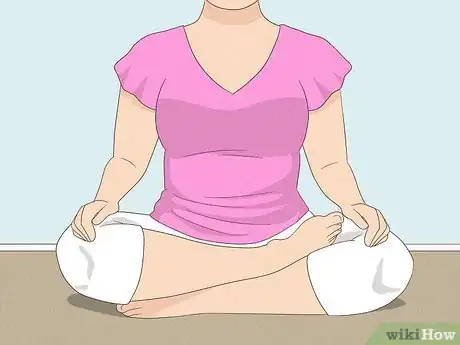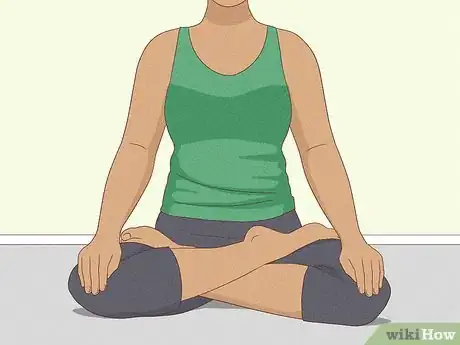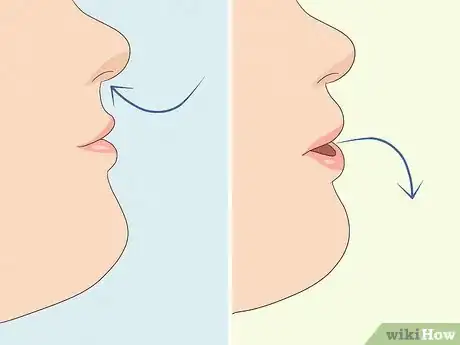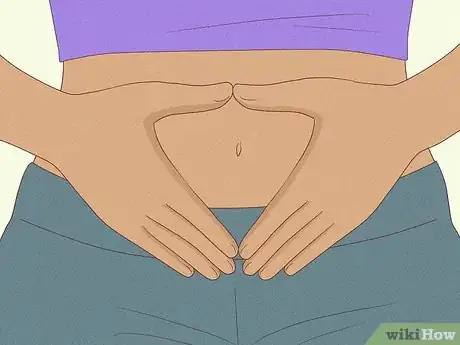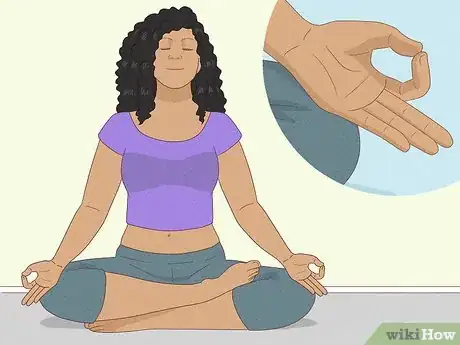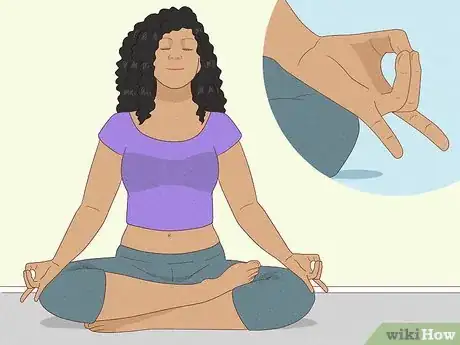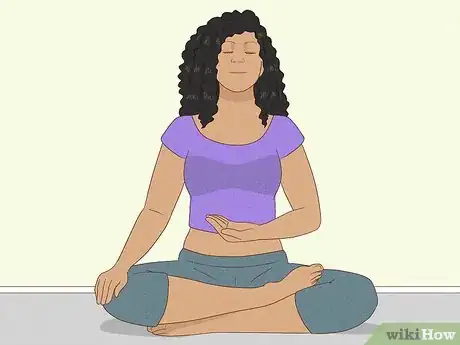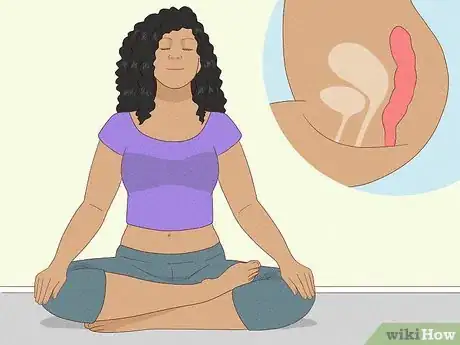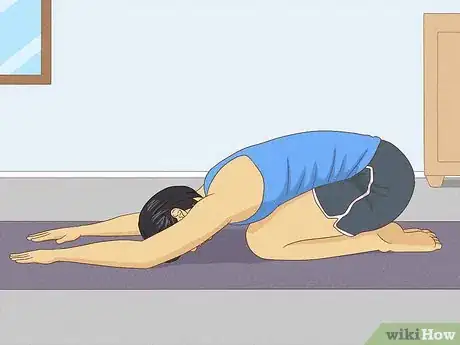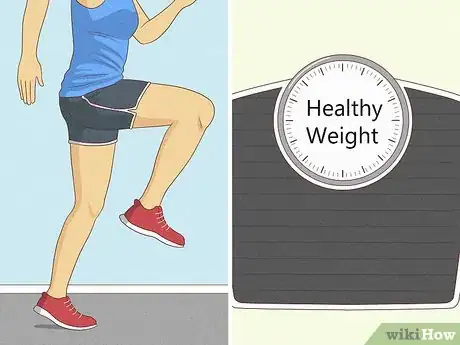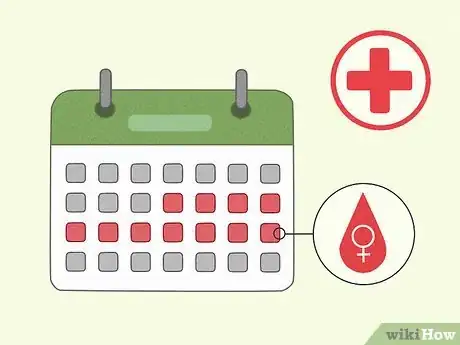This article was co-authored by wikiHow staff writer, Eric McClure. Eric McClure is an editing fellow at wikiHow where he has been editing, researching, and creating content since 2019. A former educator and poet, his work has appeared in Carcinogenic Poetry, Shot Glass Journal, Prairie Margins, and The Rusty Nail. His digital chapbook, The Internet, was also published in TL;DR Magazine. He was the winner of the Paul Carroll award for outstanding achievement in creative writing in 2014, and he was a featured reader at the Poetry Foundation’s Open Door Reading Series in 2015. Eric holds a BA in English from the University of Illinois at Chicago, and an MEd in secondary education from DePaul University.
There are 15 references cited in this article, which can be found at the bottom of the page.
This article has been viewed 77,619 times.
Learn more...
If you’re looking to get back in touch with your inner peace or center your feminine energy, you may benefit from mudras. Mudras are symbolic hand gestures designed to stimulate your senses, calm your breathing, or articulate a feeling or belief. Mudras are often combined with asanas (body movements), and in modern terms, this often looks a fair bit like yoga! Keep in mind that while the stress relief and spiritual cleansing may help your menstrual cycle regulate itself, you should totally see a doctor if you’re suddenly experiencing irregular periods or symptoms of any kind.
Steps
Getting into Position
-
1Sit comfortably in a chair if you just want to perform the mudras. Mudras only refer to the hand motions you’re going to make, and you don’t have to do anything specific with the rest of your body if you don’t want to. However, you should be comfortable! At bare minimum, just sit in a comfy chair, adjust your posture, and get comfy.[1]
- If you need a quick mindfulness check when you’re out and about but there are other people around and you can’t break out the yoga mat, sitting in a chair and performing a few mudras is a great way to go!
- You can even do mudras while you’re standing if you prefer. So long as you’re comfortable, the position isn’t a huge deal.
-
2Get into the accomplished pose (Siddhasana) for a meditative option. If you want to incorporate the mudras into a yoga session, or you’re at home and have some time, get into the accomplished pose. Sit on the floor with your buttocks flat and spine straight. Cross your legs in front of you by tucking your left foot under your right thigh, and your right foot on top of your left shin. Rest your hands on your knees.[2]
- Drop your shoulders back a bit and stick your chest out so that there’s a little bit of curve in your spine. A straight line should run from the top of your head to the center of your buttocks.
- “Siddha” comes from the Sanskrit word “divine.” This pose grounds you, and it’s commonly used for meditation.[3]
Advertisement -
3Opt for the lotus pose (Padmasana) if you’re an experienced yogi. If you’re flexible enough, the lotus pose is another great position for mudras. Sit comfortably on the floor with a straight spine. Bend your right knee to your chest and rest the side of your foot on top of your left thigh. Then, bend your left knee over your right leg and rest your left foot over your right thigh. Straighten your spine and rest your hands on your knees.[4]
- This is not a beginner position! The lotus pose can cause injury if you aren’t prepared for it, so don’t push your body here. This should be comfortable for you, not painful.
- The lotus is a symbol of rebirth. If you’re aiming to get more in touch with your femininity and internal cycle, tapping into this symbol may help you self-actualize.
-
4Regulate your breathing and slowly relax your body. You can use any breathing pattern you’d like if you’re a practicing meditator, but it’s not mandatory for mudras. At minimum, just breathe normally by inhaling through your nose and exhaling through you mouth. Breathe slowly and feel the air entering your body, filling your lungs, and exiting your mouth.[5]
- Center and relax yourself. The calmer your body is, the easier it will be to tap into your feminine spirit and become reacquainted with your body.
Performing the Mudras
-
1Use Yoni mudra to try combatting chaotic energy surrounding your womb. Bring your hands together with your fingers pointing away from your belly and hold your hands just outside of your navel. Spread your hands open with your thumbs together to form an upside-down triangle. Press your palms against your belly and breathe in and out slowly.[6]
- Hold this pose for anywhere from 10-45 minutes for maximum benefit.
- Yoga practitioners believe Yoni can help smooth out an irregular menstrual cycle. While there is no scientific evidence that mudras will impact your cycle, there’s no harm in trying. If anything, the stress relief of yoga and/or meditation can certainly help.[7]
- This mudra represents the womb of Kali, the Hindu goddess of death and time. As Kali has no time for delusion and drama, this pose aims to shred the ego and mania separating you from your body. It’s a symbol of radical self-love and feminine power.
-
2Use the Gyan mudra to soothe drowsiness and relieve stress. With your hands over your knees, tilt your palms up so that they’re facing the sky and touch your thumbs to your index fingers to form a circle. Keep your middle, ring, and little fingers extended away from you and breathe.[8]
- Yoga enthusiasts think that Gyan mudra can bring you balance and stability. If your menstrual cycle isn’t following its normal pattern, there’s no harm in giving these a shot!
- You can do this whenever you need a dose of focus and relief for however long you’d like. Gyan is Sanskrit for “knowledge” and this mudra should can redirect unpleasant physical sensations by emphasizing the intellect and drawing your energy back to your mind.
- Since this mudra helps to de-stress and soothe physical distraction, it’s ideal if you’re struggling with any kind of menstrual pain or irritation.
-
3Try the Apana mudra to purify your energy and bring balance to your life. Keep your hands on top of your knees and twist each palm up towards the sky. Bring your middle finger, ring finger, and thumb together so that they touch one another. Keep your index finger and pinky extended out away from you.[9]
- Aim to hold this mudra for 10-45 minutes based on your preferences.
- Imagine each of your fingers representing the each of the three doshas: vata (air), kapha (water), and pitta (fire).[10]
- In Apana mudra, the doshas correspond to bodily functions (namely excretion, menstruation, and ejaculation). By engaging in Apana mudra, you seek to purify your body and rebalance your body’s cycle.
-
4Perform the Dhyana mudra for feminine wisdom and tranquility. Do this with your left hand only, as the left hand represents feminine wisdom. In your seated position with your hands over your knees, slowly move your elbow out to your side. Move your left hand over your belly button so that it’s perpendicular to your spine. Turn your hand up as if you’re waiting for someone to drop a coin into your hand.[11]
- Do this for 10-45 minutes.
- As you hold your left hand outside of your belly button, feel your hand collecting all of the wisdom and serenity of the universe. Trust in your hands, and allow nature to pour its energy into your palm where it rests outside of your womb.
- You can also do this with both hands if you prefer by laying your left hand on top of your right hand with your palms facing up. When done this way, you form as triangle with your arms and head to represent the Three Jewels of Buddhism: Buddha (enlightenment), Dharma (law), and Sangha (community).
-
5Attempt the Ashwini mudra to realign yourself and soothe stomach issues. Rest your hands comfortably on your knees and sit up straight. Close your eyes. Focus your attention on your anus and inhale while you flex your sphincter slowly. Relax as you exhale and repeat this process. Do this 4-5 times to complete 1 cycle of the Ashwini mudra.[12]
- This mudra is designed to focus and elevate your life force’s energy upward along your back. By flexing and relaxing the muscle at the base of your spine (the sphincter), you push your energy from the base of your spine up to your head.
- This is believed to relieve pressure and chaos inside of your gut, which is helpful if you’re dealing with menstrual cramps or stomach pain.
- The Ashwini mudra isn’t a mudra in a traditional sense since it doesn’t involve your hands at all, but it’s a mudra in the sense that you’re performing a gesture to articulate a spiritual expression.
Making Lifestyle Changes
-
1Try going outside more often to get some vitamin D. While there aren’t a ton of natural ways to influence or control your body’s natural cycle, there is some evidence that getting enough vitamin D can help you maintain a regular period.[13] Put on sunscreen and go outside for at least 30 minutes a day if you can, and eat a diet rich in natural vitamin D.[14] This may help with any irregularities in your menstrual cycle.[15]
- Fatty fish, liver oil, mushrooms, cheese, yogurt, and chicken are great sources of vitamin D if you’re looking for inspiration in the kitchen![16]
-
2Relax and de-stress if you’re going through a lot right now. It’s possible that yoga, meditation, and mudras help to regulate your menstrual cycle by helping you relax. Stress and emotional pain can do funny things to your body’s hormone levels, and finding ways to relax may help you bring your menstrual cycle back to its regular pattern.[17]
- If you’ve always had an irregular cycle, that may simply be your body’s natural pattern.
-
3Exercise regularly and maintain a healthy weight. Get at least 150 minutes of physical activity in a week to stay fit.[18] If you could lose or gain some weight, adjust your diet accordingly to get back into a normal BMI range. Staying physically healthy will make it easier for your body to regulate itself, and if you’re experiencing an irregular period this may help a ton![19]
- Extreme swings in your weight can mess with your menstrual cycle, so if you want to lose weight, skip the crash diets and focus on a more consistent approach.
-
4See a doctor if you’re having any kind of irregular symptoms. Irregular menstruation isn’t always a sign that something is wrong. You know your body best, though. If your period has suddenly changed in a dramatic way, see a doctor just to be safe.[20]
- Sudden changes that merit a trip to the doctor include:
- A dramatic change in your period’s frequency.
- An extended or painful period.
- Your period occurs more often than every 21 days, or less often than every 35 days.
- It’s not uncommon for your cycle to slowly become more and more irregular in the decade or so leading up to menopause.[21]
- Sudden changes that merit a trip to the doctor include:
References
- ↑ https://www.yogapedia.com/definition/6867/apana-mudra
- ↑ https://www.yogabasics.com/asana/accomplished-pose/
- ↑ https://www.yogapedia.com/definition/6520/siddha-yoni-asana-yoga
- ↑ https://www.rituals.com/en-us/mag-spirituality-meaning-lotus-flower.html
- ↑ https://www.easyayurveda.com/2020/06/26/ashwini-mudra/</ref
- ↑ https://www.yogajournal.com/practice-section/mudra-women-need-detach-lifes-chaos/
- ↑ https://www.pennmedicine.org/updates/blogs/womens-health/2020/november/irregular-periods-why-is-my-period-late
- ↑ https://www.artofliving.org/us-en/yoga-mudras-for-relieving-anxiety
- ↑ https://www.yogapedia.com/definition/6867/apana-mudra
- ↑ https://www.ncbi.nlm.nih.gov/pmc/articles/PMC3215408/
- ↑ https://web.stanford.edu/class/history11sc/pdfs/mudras.pdf
- ↑ https://www.yogapedia.com/definition/6426/ashwini-mudra
- ↑ https://scholarworks.umass.edu/cgi/viewcontent.cgi?article=1547&context=dissertations_2
- ↑ https://ods.od.nih.gov/factsheets/VitaminD-HealthProfessional/
- ↑ https://scholarworks.umass.edu/cgi/viewcontent.cgi?article=1547&context=dissertations_2
- ↑ https://ods.od.nih.gov/factsheets/VitaminD-HealthProfessional/
- ↑ https://www.pennmedicine.org/updates/blogs/womens-health/2020/november/irregular-periods-why-is-my-period-late
- ↑ https://www.cdc.gov/physicalactivity/basics/adults/index.htm
- ↑ https://www.nhs.uk/conditions/irregular-periods/
- ↑ https://www.pennmedicine.org/updates/blogs/womens-health/2020/november/irregular-periods-why-is-my-period-late
- ↑ https://newsnetwork.mayoclinic.org/discussion/mayo-clinic-q-and-a-menstrual-irregularities-not-uncommon-in-decade-prior-to-menopause/

